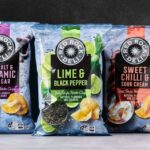Food ingredients always play a vital role in product acceptance in the marketplace. The food ingredient industry is getting innovative in line with the emerging trends of health-conscious consumers, they are working closely with industries to develop new products, observes Rajat K Baisya.
The food processing industry is one of the largest industries in India, ranking fifth in terms of production, consumption, and exports. The Indian food and grocery market is the world’s sixth-largest, with retail contributing 70 percent of the sales. The Indian food processing industry accounts for 32 per cent of the country’s total food market, one of the largest industries in India. It contributes around 8.80 and 8.39 per cent of Gross Value Added (GVA) in Manufacturing and Agriculture, respectively, 13 per cent of India’s exports and six per cent of total industrial investment.
Globally, the food ingredients industry is estimated to be worth USD 400 billion. However, India has a small share of this, estimated at USD 700 million, or only about 0.2 per cent of the total global industry. India contributes about 2.5 per cent of international trade in agriculture and processed food. In contrast, India’s share of food ingredients is 0.2%, which is less than 10% of India’s share in global trade of food and agriculture products in this category.
We can define a food ingredient as a substance usually added to any food during its preparation and processing to achieve the desired effect in terms of food’s appearance, texture, taste, mouthfeel, and overall acceptability of the foods.
Food Ingredients Industry in India is Getting Innovative
One of the most exciting developments has been the increasing use of functional and natural ingredients, such as herbs, spices, and plant extracts. These components are being used to develop functional foods and phyto-medicines from spices that not only taste good but also provide health benefits.
The growing demand for clean-label and health-oriented products is pushing manufacturers to rethink their ingredient lists. Innovations in food processing and ingredient formulation are enabling the creation of foods with enhanced nutritional profiles and longer shelf life. Companies are now exploring options such as plant-based food innovations, alternative proteins, and novel sweeteners.
Another significant area of growth is the fortification of staples. Projects like soy-fortified biscuits are being rolled out to address malnutrition and protein deficiency in specific population groups. Similarly, natural ingredients such as yeast extract are gaining popularity due to their clean-label appeal and umami-enhancing properties.
The food colours and flavour industry has also seen major advances. Companies are working on solutions that not only enhance visual appeal but also meet regulatory and clean-label requirements. For instance, Oterra’s new colour blending and application center in India reflects growing demand for natural food colours.
In the sweetener segment, manufacturers are exploring low-sugar and no-sugar options that don’t compromise on taste. Innovations like the role of maltitol in low-sugar chocolates are helping brands cater to diabetic and health-conscious consumers.
Major food ingredients
Broadly, we can classify food ingredients as major ingredients, which are the bulk and primary ingredients of food. In that list, we will have sugar, water, wheat flour, rice, meat, fish, poultry, fruit, vegetables, cereals, milk, etc., depending on the type of foods that need to be processed and or to be prepared. For example, for protein food products, ingredients such as soy protein isolate, peanut protein isolate, and milk casein will be the major food ingredients.
Minor food ingredients
And then we have minor ingredients that constitute a very small part of the food but play a vital role in terms of overall taste and acceptability of the end product, and, as such, are very important. That list would be very long and almost endless. It will include colour, flavour, preservatives, additives, emulsifiers, stabilisers, spices, and condiments, among others. Food ingredients play a specific role and function in food processing, packaging, and storage. While major ingredients that constitute the bulk of the food will always be natural, these minor food ingredients can be natural, natural-identical, or artificial food ingredients.
Consumers are now becoming averse to artificial food ingredients. Thus, food processors are increasingly shifting to natural food ingredients, and they also make various claims to improve the prospects of sales and demand for their products in the market. Food ingredients, as such, play a vital role in the success of any processed food and drive the growth of the industry category.

Sometimes, some food ingredients come under the lens and are declared banned or even restricted for use, putting the industry in a fix and forcing them to try out alternative ingredients that are generally recognised as safe and permitted by the authorities.
Safer and permitted food ingredients
Sometimes, certain food ingredients come under scrutiny and are declared banned or restricted for use, putting the industry in a bind and forcing them to try out alternative ingredients that are generally recognised as safe (GRAS) and permitted by regulatory authorities. We have seen how the industry has responded to such occasional threats when a particular food ingredient, which has been in use for years, has been declared ‘not permitted anymore ’ overnight. Businesses must find alternative materials and shift to new ingredients to remain in business.
Two examples can be cited to illustrate this point. During the seventies and eighties, the carbonated soft beverages industry used ‘Brominated Vegetable Oil (BVO)’ as a cloudifying agent to give body to orange-like Gold Spot and Fanta and lemon-lime Limca kind of beverages. This BVO was under cloud, and the industry was expecting that BVO would be banned and was getting ready for an alternative. BVO was considered carcinogenic and was banned in many countries in those days, and one day, it was declared non-permitted in India as well. The industry changed to gum acacia-based emulsifiers to tide over the apparent difficulty and transitioned to safer and permitted food ingredients.
I recollect in those days that we were conducting storage and shelf stability studies with gum Arabic-based flavour emulsions base. The concept of clear lemon-lime beverages, such as Sprite, emerged at that time, marking the creation and innovation by the marketer, which ultimately became a distinct product category. This product category was promoted and advertised as the youngsters’ trendy choice for their lifestyle.
All promotional messages and advertisement films were made to depict the product as a choice for the new generation. And it worked. Readers can easily correlate with the advertisements and TV commercials for Mountain Dew of Pepsi Cola. It is interesting to note that, for one category of products, technologists and R&D scientists were trying to work with a substitute ingredient to replace BVO. At the same time, marketers created yet another trendy category, such as clear beverages.
Yet another example is Monosodium Glutamate (MSG), a permitted ingredient as a flavour enhancer for meat flavour and used in instant noodles. Later, it was banned, but then re-entered the list of permitted ingredients. Still, its use has been restricted, and now it can only be used after a declaration is made statingthat the food is not suitable and safe for children under 12 years of age and pregnant women.
Readers will recollect the most publicised case of MSG in Nestle’s Maggi instant noodles. It happened with the world’s number one food company, Nestle, and they survived the impact on their image and also the loss of sales. Had it been with any other corporations in India, their entire business would have been wiped out. But Nestle came back with renewed energy and enthusiasm. Other players took advantage of the opportunity to deliver better growth when Maggi was temporarily withdrawn from the market. MSG was replaced by yeast extract, a natural food ingredient that is now widely used as a meat flavour enhancer.
Local investments in food ingredients manufacturing are low. Most of the food ingredients available and used in the food processing industry in India are imported from other countries. Food ingredient manufacturing companies from abroad operate through their representatives in India. Some of them have smaller development and formulation centres established in India to work closely with the industry, helping them develop products targeted at specific markets and consumers within a typical competitive set to operate and achieve success. All large global flavour manufacturers like IFF are operating in India.
The food ingredient industry is also innovative, and in line with the emerging trends of health-conscious consumers, it is working closely with other sectors to develop new products. For example, yeast extract is now available for use in low-sodium foods. Some of the food ingredients can reduce the sugar content in food. In addition, many natural food ingredients are replacing artificial sweeteners. Food ingredient manufacturers supply a mix that can be directly baked into various types of end products in the bakery industry.
There are consultants in the market who support the small and medium-sized bakery industry in their product development efforts. I know Yusuf Patanwala of Autobake in Mumbai, who has been doing very credible work in promoting and developing new products and businesses in the bakery industry. They represent leading bakery equipment manufacturers of Europe in India as well.
Sustainability is another focus area. Startups and established players alike are looking at how ingredients can be sourced, processed, and packaged more responsibly. The rise of lab-grown meat and other cellular agriculture products is one such breakthrough on the horizon.
Food ingredients manufacturers play a vital role in making food widely accepted in the market. And to deliver the growth in the processed food industry, the food ingredient industry also must grow.
The author is the chairman of Strategic Consulting Group and served as Professor and Head of the Department of Management Studies, IIT Delhi.

















